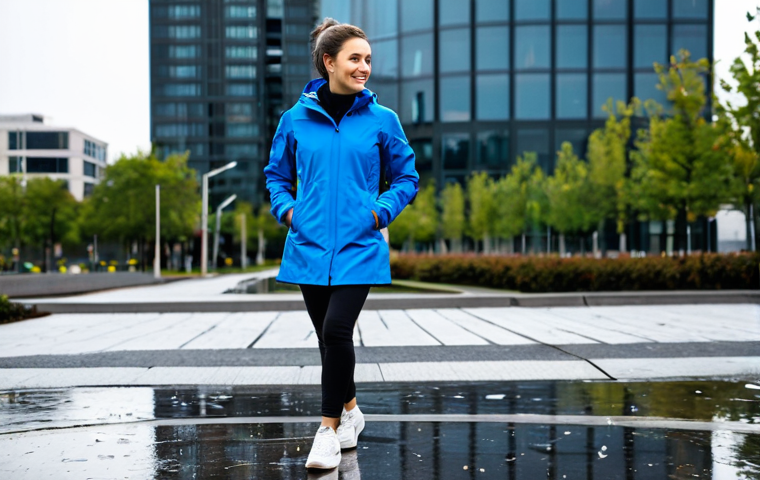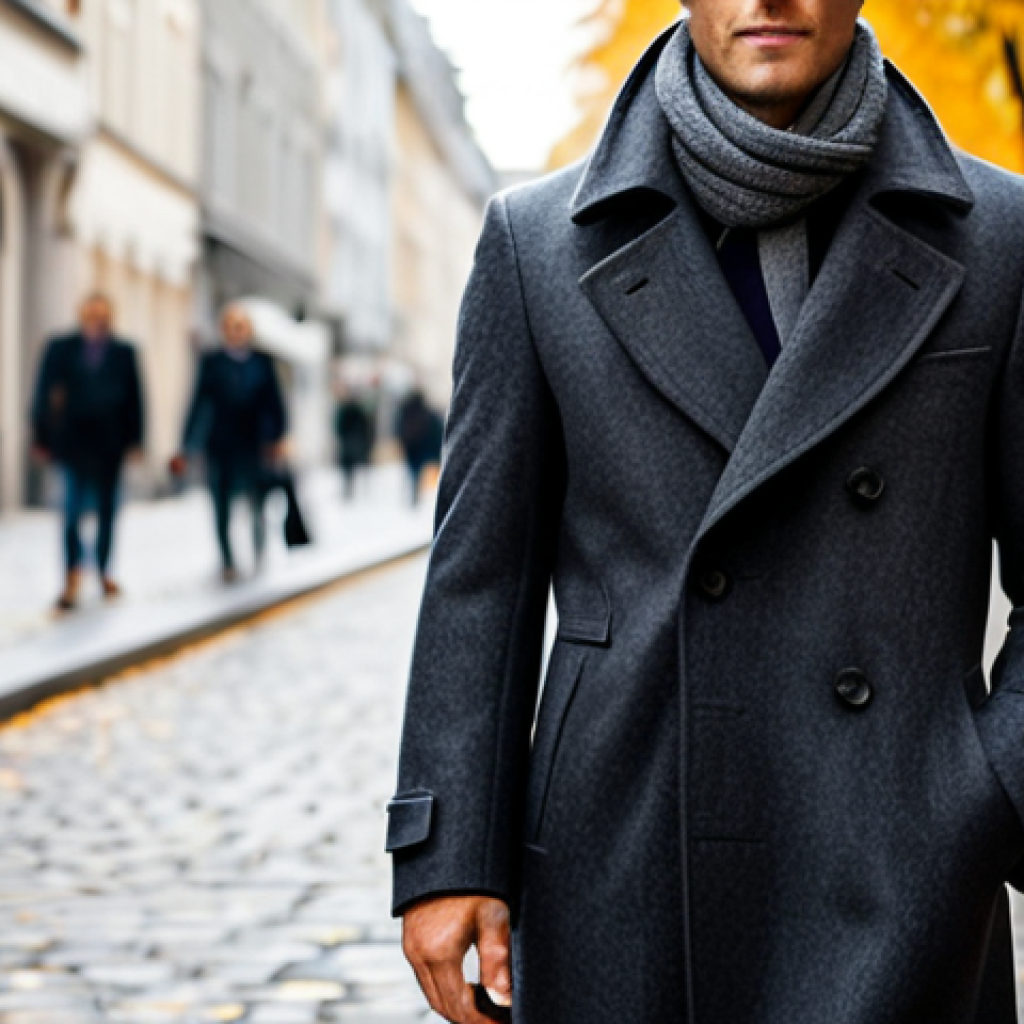Have you ever found yourself utterly perplexed when choosing a new winter coat, staring at a rack filled with what seems like endless options, each promising warmth but made from something entirely different?
From my own experience navigating countless stores and even online reviews, picking the right material for a men’s coat feels far more complex than just picking a color or style.
It’s not just about staying warm anymore; in our rapidly changing world, with unpredictable weather patterns and a growing emphasis on conscious consumption, the fabric your coat is made from carries significant weight.
What I’ve come to realize is that the choice between, say, a rich wool, a high-tech synthetic blend, or a luxurious cashmere isn’t merely about comfort; it reflects a broader shift in consumer values.
People are increasingly prioritizing sustainability and longevity, demanding materials that not only perform exceptionally but also align with ethical sourcing and environmental responsibility.
We’re moving away from fast fashion towards investment pieces, ensuring our attire can withstand both the elements and the test of time, a crucial consideration given today’s economic climate.
The tactile feel, durability, and even how a material ages all play a pivotal role in determining a coat’s true value and its future place in your wardrobe.
So, let’s explore this in detail below and uncover the definitive differences between men’s coat materials.
Embracing the Timeless Comfort of Natural Fibers

1. The Enduring Majesty of Wool and Its Varieties
There’s something inherently comforting and deeply traditional about a wool coat, isn’t there? I remember the first truly cold winter I spent up north; my flimsy synthetic jacket just wasn’t cutting it. It was then that I truly understood the hype around a proper wool overcoat. Wool, particularly virgin wool or merino, offers incredible warmth without excessive bulk, thanks to its natural crimp that traps air and acts as an insulator. What really struck me, though, beyond the warmth, was how it managed moisture. Unlike synthetics that can feel clammy when you sweat even a little, wool somehow wicks moisture away, keeping you dry and comfortable. I’ve worn wool coats in everything from a light drizzle to a full-blown blizzard, and while they aren’t fully waterproof, they’re surprisingly resilient against light precipitation because of the natural lanolin. The sheer durability of a good wool coat is also a major selling point for me. I’ve got a classic tweed coat that my grandfather used to wear, and it’s still in fantastic shape, proving that these aren’t just purchases for a single season but genuine investments. However, the weight can sometimes be a consideration, especially for prolonged wear or travel, and some people do find it a bit itchy if it’s not fine merino. For me, the rich texture and natural feel of a high-quality wool simply can’t be replicated, making it a foundational piece in any discerning wardrobe.
2. The Unrivaled Softness and Luxury of Cashmere
Stepping into the realm of true luxury, cashmere is a material that, once experienced, is hard to forget. It’s derived from the soft undercoat of cashmere goats, and let me tell you, the difference in touch is immediate and profound. My first cashmere blend scarf was a gift, and I vividly recall the moment I felt its unparalleled softness – it was like wearing a cloud. For coats, pure cashmere offers superior warmth-to-weight ratio compared to almost any other fiber. It’s incredibly light yet remarkably insulating, making it perfect for those who want elegance without the heft. However, this sublime softness comes with a significant price tag and a higher degree of delicacy. You can’t just toss a cashmere coat into the washing machine like you might with a more robust wool blend; it requires careful dry cleaning and gentle handling. I’ve learned the hard way that moths absolutely adore cashmere, so proper storage during off-seasons is paramount. While a 100% cashmere coat might be a splurge for most, even blends with a good percentage of cashmere can elevate a coat’s feel and warmth significantly, offering a touch of that luxury without breaking the bank entirely. It’s about understanding that you’re paying for an experience, a level of comfort that few other materials can provide, and for me, it’s an indulgence worth considering for those special, elegant occasions.
The Cutting Edge: Decoding Synthetic and Performance Blends
1. The Practicality and Versatility of Polyester and Nylon
When you think of modern outerwear, it’s almost impossible not to think of synthetics like polyester and nylon. I’ve had my fair share of synthetic jackets, especially for outdoor activities where durability and weather resistance are paramount. What I’ve personally found most appealing about these materials is their incredible water resistance and quick-drying properties. If you’re caught in a downpour, a good quality polyester or nylon coat will shed water like a duck, keeping you remarkably dry. They’re also incredibly lightweight, which is a huge bonus for active lifestyles or when you need a packable option for travel. I remember a trip where space was limited, and my compressible nylon puffer coat was an absolute lifesaver. The technology has advanced so much that many modern synthetics can mimic the feel of natural fibers, and they’re often much more affordable. However, there’s a trade-off: breathability. While they excel at keeping water out, they can sometimes trap heat and moisture *in*, leading to that slightly clammy feeling if you’re exerting yourself or if the temperature fluctuates. Also, from my personal observation, they don’t always age with the same grace as natural fibers; they can sometimes develop a sort of sheen over time or show wear in ways that wool might not, which is a factor if you’re looking for a piece that truly lasts aesthetically for decades.
2. The Innovative World of Modern Performance Fabrics
Beyond basic polyester and nylon, the world of performance fabrics has exploded, bringing materials like Gore-Tex, Thinsulate, and various proprietary blends into the mainstream. These aren’t just about keeping you dry; they’re engineered for specific performance metrics. Gore-Tex, for instance, is a marvel of engineering, offering a waterproof *and* breathable membrane that truly works. I’ve put a Gore-Tex jacket through its paces on countless rainy hikes, and it’s genuinely transformative to be completely dry without feeling like you’re in a sauna. Thinsulate, on the other hand, focuses on insulation, using microfibers to trap air more efficiently than traditional down, often with less bulk. These fabrics are usually part of a multi-layered system, designed to provide optimal protection against extreme conditions while maintaining comfort. The downside, if you can call it that, is often the cost, which can rival or even exceed some natural fiber coats, and the fact that their performance can sometimes degrade over time with improper washing. You really need to follow care instructions meticulously to maintain their integrity. But for specific needs, like serious outdoor sports or very wet climates, these performance blends are, in my experience, absolutely unbeatable. The continuous innovation in this space means there’s always something new emerging, pushing the boundaries of what outerwear can achieve.
The Blended Advantage: Merging Comfort with Durability
1. Optimizing Warmth and Wear with Wool Blends
Wool blends have become incredibly popular, and for good reason. From my perspective, they strike a fantastic balance between the luxurious feel and natural insulating properties of wool, with the added benefits of synthetic fibers. You’ll often find wool mixed with polyester, nylon, or even a touch of cashmere. The polyester or nylon component typically adds durability, making the coat more resistant to abrasion and pilling, and can also improve its water resistance. I’ve owned a few wool-poly blend peacoats, and I’ve found they hold their shape better and are less prone to wrinkling than pure wool. They also tend to be more affordable, making a high-quality wool-like experience accessible to more people. The addition of a small percentage of cashmere or even silk can significantly enhance the softness and drape of the fabric without incurring the full cost or delicacy of pure cashmere. This hybrid approach often results in a coat that’s warm, relatively lightweight, durable, and easier to care for than its 100% natural counterparts. It’s truly a sweet spot for everyday wear where you need both performance and a classic aesthetic, making them a very practical and stylish choice for the modern man who seeks versatility without compromise.
2. Innovative Hybrids for Modern Lifestyles
The innovation in fabric blending doesn’t stop at just wool and synthetics. Manufacturers are constantly experimenting, creating hybrid fabrics that target very specific needs. Think about stretch fabrics, where a small percentage of elastane (spandex) is woven into wool or cotton blends. I recently tried on a sport coat with a wool-elastane blend, and the freedom of movement it offered was genuinely surprising. It maintained the sophisticated look of wool but moved with me in a way pure wool simply couldn’t. Then there are blends designed for specific climates, like those incorporating moisture-wicking properties into traditional materials or even anti-microbial treatments. These aren’t just about warmth anymore; they’re about active comfort and functionality in dynamic environments. While these specialized blends can sometimes be niche or more expensive, they offer solutions to challenges that traditional materials alone can’t address, truly pushing the boundaries of what a coat can do for you beyond just keeping you warm. It’s an exciting space to watch, as new materials constantly emerge, promising even better performance and comfort tailored to our increasingly active and varied lifestyles. The possibilities seem endless for how these materials will continue to evolve.
Sustainability and Ethical Sourcing: A Modern Imperative
1. Navigating Eco-Friendly Choices in Outerwear
In today’s world, simply choosing a warm coat isn’t enough; we’re increasingly aware of the environmental and ethical impact of our purchases. This has become a huge factor for me personally when I’m considering any new clothing item. Brands are now making significant efforts to source materials responsibly, and as consumers, we have a role to play too. For natural fibers, this means looking for certifications like the Responsible Wool Standard (RWS), which ensures animal welfare and land management practices are met. I’ve actively sought out brands that are transparent about their supply chain because it speaks volumes about their commitment. For synthetics, the focus shifts to recycled content, like recycled polyester made from plastic bottles, which helps reduce waste and reliance on virgin petrochemicals. I remember seeing a jacket made from entirely recycled materials and thinking, “This is the future.” It’s not just about the material itself but how it’s produced, dyed, and ultimately, how it will be disposed of. It’s about moving beyond just what feels good to what does good, and it feels empowering to make choices that align with these values, knowing you’re contributing to a more responsible industry.
2. The Circular Economy and Longevity: Investing Wisely
Part of sustainable consumption is not just about the material’s origin, but its longevity and potential for reuse or recycling. This ties directly into the idea of investing in quality over quantity. A well-made wool or cashmere coat, though a higher upfront cost, can last decades with proper care, drastically reducing its environmental footprint compared to a cheap, fast-fashion item that might only last a season or two. I’ve inherited pieces that have stood the test of time, and that’s the kind of sustainable fashion I truly believe in. Furthermore, brands are exploring “circular” designs, where garments are made from materials that can be easily recycled into new products at the end of their life. This is a game-changer. When I’m looking at a coat now, I don’t just think about how it looks, but also about its potential lifespan and what happens to it after I’m done with it. Does it feel like something I’ll repair if it gets a tear, or will it just end up in a landfill? Choosing durable, high-quality materials is a direct investment in both your wardrobe and the planet’s future, a philosophy I’ve come to embrace wholeheartedly as part of a more conscious approach to personal style and consumption.
| Material Type | Key Characteristics | Typical Use Case | Pros | Cons |
|---|---|---|---|---|
| Wool (Virgin/Merino) | Natural fiber, excellent insulation, moisture-wicking | Classic overcoats, peacoats, blazers | Warm, breathable, durable, naturally water-resistant, timeless appeal | Can be heavy, may itch (less so with merino), requires dry cleaning, prone to moths |
| Cashmere | Luxury natural fiber, extremely soft, lightweight | High-end dress coats, fine scarves | Unparalleled softness, excellent warmth-to-weight ratio, luxurious feel | Very expensive, delicate, high maintenance (dry clean only), very prone to moths |
| Polyester/Nylon | Synthetic, water-resistant, durable, quick-drying | Raincoats, puffers, casual jackets | Lightweight, water-resistant, durable, affordable, easy to care for | Less breathable, can feel clammy, less luxurious feel, non-biodegradable |
| Gore-Tex/Technical Synthetics | Engineered membranes, waterproof, breathable | Performance outerwear, hiking jackets, extreme weather coats | Superior weather protection, highly breathable, lightweight for performance | Expensive, can degrade with improper care, often has a “techy” look |
| Wool Blends | Mix of wool with synthetics (polyester, nylon) or other natural fibers (cashmere, silk) | Everyday coats, versatile overcoats | Balanced warmth, durability, often more affordable and easier to care for than pure wool | Quality varies greatly by blend percentage, can lose some natural properties |
Warmth, Weight, and Breathability: The Performance Triangle
1. Striking the Perfect Balance for Diverse Climates
When you’re trying to pick out a coat, it’s not just about how warm it *feels* on the hanger; it’s about how it performs in different conditions. This is a lesson I learned the hard way after buying an incredibly warm, but incredibly heavy, wool coat for a trip to a mild winter climate. I ended up sweating profusely indoors! The interplay between warmth, weight, and breathability is crucial. A coat can be incredibly warm, but if it’s also incredibly heavy, it can be uncomfortable for extended wear. Similarly, if it’s warm but lacks breathability, you’ll feel stuffy and damp if you’re active. Down and high-tech synthetics like Thinsulate often offer excellent warmth-to-weight ratios, making them ideal for very cold climates where you still need mobility. Wool, while heavier, often provides superior breathability compared to many synthetics, making it comfortable across a wider range of temperatures, as it can regulate body temperature more effectively. It’s about understanding your specific needs. Are you commuting in sub-zero temperatures, or do you need something for brisk autumn walks? The answer dictates which material properties you should prioritize, ensuring your coat is a functional asset, not a hindrance, in your daily life.
2. The Role of Construction and Layering in Overall Performance
It’s not just the primary material that determines a coat’s performance; the construction plays an equally vital role. Think about insulation layers, linings, and even the weave of the fabric. A thin wool overcoat might not be enough on its own in bitter cold, but when paired with a quality inner lining (like Thinsulate or even a removable down liner), it can become a fortress against the elements. I’ve found that coats with thoughtful details, like taped seams in waterproof jackets or articulated sleeves for better movement, significantly enhance overall comfort and functionality. Furthermore, the concept of layering is paramount, especially when considering different materials. A lightweight, breathable base layer, an insulating mid-layer (perhaps a fleece or a thin wool sweater), and an appropriate outer shell (the coat itself) can provide far more versatile warmth than a single, overly bulky coat. This allows you to adapt to changing temperatures throughout the day or across different activities, maximizing the utility of your outerwear wardrobe. It’s a system, not just a single piece, and understanding how materials interact within that system is key to staying comfortable in any weather condition, from a mild autumn evening to a harsh winter storm.
Maintenance and Longevity: Protecting Your Investment
1. Practical Care Tips for Natural Fibers
Alright, so you’ve invested in a fantastic coat, probably one made from wool or a luxurious blend. Now, how do you make sure it lasts? This is where proper care really comes into play, and frankly, it’s often overlooked. For wool coats, the biggest piece of advice I can give is to brush them regularly with a soft garment brush to remove surface dirt and lint. This not only keeps them looking sharp but also prevents dirt from embedding itself into the fibers, which can eventually break them down. I’ve personally found that airing out a wool coat after each wear, rather than immediately stuffing it into a closet, significantly helps to keep it fresh and reduce the need for frequent dry cleaning. Spot cleaning minor spills immediately with a damp cloth can save you a trip to the dry cleaner. And speaking of dry cleaning, it’s usually recommended annually or bi-annually, depending on how often you wear it. Never machine wash a structured wool coat unless the label explicitly says you can (which is rare!). Proper storage during off-seasons is also crucial: use wide, padded hangers to preserve the shoulder shape and store it in a breathable garment bag to protect it from dust and moths. Trust me, a little effort here goes a very long way in preserving your investment and ensuring it looks as good as new for years, even decades, to come.
2. Caring for Synthetics and Performance Fabrics
Caring for synthetic and performance coats is a different ball game, but equally important for maintaining their integrity and performance. The primary concern here is often preserving their water-repellent (DWR) finish and the integrity of any waterproof membranes like Gore-Tex. Most synthetic coats can be machine washed, but it’s critical to use a gentle cycle with cold water and a specialized technical wash detergent that won’t strip the DWR coating. Avoid fabric softeners at all costs, as they can clog the pores of breathable membranes. Tumble drying on a low heat setting can often help reactivate the DWR finish. I’ve made the mistake of using regular detergent on a technical shell, and I noticed a significant drop in its water repellency afterward – a lesson learned! For puffer coats with synthetic insulation, a few tennis balls in the dryer can help fluff up the insulation. If your waterproof jacket starts to “wet out” (absorb water rather than bead it off), it might be time to reapply a DWR spray or wash-in treatment. By following these specific care instructions, you’ll ensure your high-tech outerwear continues to perform as intended for many seasons to come, which is crucial given their often higher price point and specialized function, truly extending the life of your essential gear.
Matching Material to Your Lifestyle: The Ultimate Guide
1. Defining Your Everyday Needs and Climate
Okay, so we’ve talked a lot about different materials and their properties, but how do you actually translate all of that into choosing the right coat for *you*? This is where I start by asking myself: What’s my typical day like? Am I commuting through a bustling city, facing unpredictable subway drafts and sudden downpours? Am I spending hours outdoors in genuinely freezing temperatures, or is my winter more about crisp, cool days? For city dwellers, a mid-weight wool blend or even a sleek insulated synthetic might be ideal – something that’s warm enough for short bursts outside but not overly bulky for public transport or indoor environments. If you live in a place with consistently harsh winters, you’ll need serious insulation, whether that’s a high-fill power down parka or a robust technical synthetic coat. Conversely, for milder climates, a well-made unlined wool overcoat or a stylish trench made from a water-resistant cotton blend might be all you need. It’s about being brutally honest about your actual climate and activities, not just what looks good in a fashion magazine. I’ve seen too many people buy coats that are either overkill or completely inadequate for their real-world needs, leading to buyer’s remorse and a wasted investment, which we definitely want to avoid.
2. Personal Style and Investment Philosophy
Beyond pure functionality, your personal style and investment philosophy play a massive role. Are you someone who prefers classic, timeless pieces that can be worn for years, even decades? Then investing in a high-quality wool or cashmere blend coat that will age gracefully and stand the test of seasonal trends is probably your best bet. These materials often exude a certain sophisticated elegance that’s hard to replicate with synthetics. On the other hand, if you’re more into a modern, technical, or athletic aesthetic, or if you frequently engage in outdoor pursuits, then high-performance synthetics and their innovative features will likely align better with your style and practical requirements. Consider how the coat fits into your existing wardrobe. Will it complement your other clothes, or will it stick out like a sore thumb? And what’s your budget? While a pure cashmere coat might be the dream, a high-quality wool blend could offer 90% of the luxury feel at a fraction of the cost. Ultimately, the “best” material isn’t universally defined; it’s the one that perfectly balances warmth, durability, aesthetics, and ethical considerations with your unique lifestyle and financial comfort. It’s a personal journey, and understanding these material nuances empowers you to make an informed decision you won’t regret, truly building a wardrobe that serves you well.
The Tactile Experience: Beyond Practicality
1. The Feel and Drape That Define Quality
Beyond just warmth and water resistance, there’s an undeniable sensory experience that comes with a well-made coat. The way a fabric feels against your skin, the way it drapes over your shoulders, the subtle sheen or texture – these are often what elevate a coat from merely functional to truly exceptional. I’ve found myself instinctively reaching for coats that simply *feel* good, even if another one might technically offer marginally more warmth. A fine wool, for example, has a natural spring and a certain “give” that molds to your body over time, developing a unique character. Cashmere, of course, is in a league of its own for softness, offering a comforting embrace that no synthetic can truly replicate, no matter how advanced the technology. Even a well-constructed cotton twill or canvas has a satisfying stiffness and robustness that speaks of durability and classic utility. Synthetics, while amazing for performance, sometimes lack that natural, organic feel; they can feel a bit “plastic-y” or overly smooth. It’s a subtle but significant distinction that speaks to the craftsmanship and inherent quality of the material. For me, the tactile experience is a huge part of the overall enjoyment and long-term satisfaction of wearing a coat, influencing not just comfort but also how confident and put-together I feel when I wear it.
2. The Aesthetic and How Materials Influence Style
Finally, let’s talk about the visual impact. The material of your coat dramatically influences its aesthetic and how it fits into different style profiles. A luxurious camel hair coat or a refined herringbone wool immediately conveys a sense of classic elegance and sophistication, perfect for formal wear or smart casual ensembles. These materials inherently possess a rich texture and depth of color that’s simply beautiful to behold. On the other hand, a sleek, minimalist nylon puffer jacket speaks to a more modern, active, or streetwear-inspired look. Its smooth surface and clean lines are perfect for a contemporary urban environment. Technical fabrics often have a matte finish or subtle ripstop texture that signals performance and ruggedness, ideal for adventurous spirits. What I’ve learned is that the material isn’t just a functional choice; it’s a profound stylistic statement. Are you aiming for timeless sophistication, modern utility, or rugged adventure? The fabric choice is the first and often most powerful brushstroke in defining your coat’s aesthetic, allowing you to curate a wardrobe that truly reflects who you are and where you’re going, adding an essential layer to your personal brand and overall presentation.
Closing Thoughts
As we’ve explored the intricate world of coat materials, I hope you’ve gained a deeper appreciation for the thought and innovation that goes into crafting these essential garments. From the comforting embrace of natural wool to the cutting-edge performance of modern synthetics, each material offers a unique blend of characteristics. My journey through countless coats has taught me that the “best” choice is truly personal, a thoughtful synergy of your lifestyle, climate, style, and values. Ultimately, armed with this knowledge, you’re now empowered to make a choice that not only keeps you warm but genuinely enhances your life and reflects your discerning taste.
Useful Information to Know
1. Check Care Labels Religiously: This is your coat’s instruction manual. Ignoring it, especially for delicate natural fibers or technical synthetics, is a sure way to shorten its lifespan. Always follow the manufacturer’s recommendations.
2. Consider Your Local Climate, Not Just the Season: A coat perfect for a snowy New York winter might be overkill for a mild London autumn. Be honest about your actual weather conditions and daily activities.
3. Invest in Quality Hangers and Storage: For structured coats, wide, padded hangers prevent shoulder deformation. Breathable garment bags protect against dust and moths, especially for wool and cashmere, preserving your investment.
4. Layering is Your Best Friend: Don’t rely solely on one heavy coat. A versatile outer shell combined with adaptable mid-layers (like sweaters or thin fleeces) allows you to adjust to temperature fluctuations throughout the day, maximizing comfort.
5. Think Beyond the Price Tag: Cost Per Wear: A more expensive, high-quality coat that lasts a decade is often a better investment than a cheap one that needs replacing every season. Divide the cost by the number of times you’ll wear it to see its true value.
Key Takeaways
Choosing the right coat material involves balancing warmth, weight, breathability, durability, and aesthetic appeal with your personal lifestyle and ethical considerations. Natural fibers like wool and cashmere offer timeless comfort and luxury, while synthetics provide unparalleled performance and practicality. Blended fabrics often combine the best of both worlds, and understanding care instructions is crucial for longevity. By aligning your coat choice with your needs, style, and values, you can make a truly informed investment that serves you well for years to come.
Frequently Asked Questions (FAQ) 📖
Q: Given the increasing emphasis on sustainability, which coat materials truly stand the test of time and are generally considered better for the environment?
A: Oh, this is such a critical question these days, isn’t it? From my own journey trying to make more conscious choices, I’ve really leaned into natural fibers like high-quality wool – think Merino or even a good blend.
They’re incredibly durable, naturally breathable, and here’s the big one: they’re biodegradable, meaning they won’t sit in a landfill for centuries. I’ve got a robust tweed coat that I’ve practically lived in for a decade, and with just a bit of care, it still looks fantastic.
On the flip side, synthetics are trickier. While recycled polyester is a step in the right direction, and I appreciate the innovation there, the microplastic issue is real, and their end-of-life cycle is still a big problem.
My personal philosophy now is to invest in pieces that last, so you’re buying less often. It’s not just about the planet; it’s also about avoiding the headache of replacing a flimsy coat every other winter.
Q: Beyond just warmth, what are the practical differences in everyday use and care between common men’s coat materials like wool, cashmere, and synthetics?
A: Okay, this is where the rubber meets the road, because a coat needs to fit into your actual life. Wool, especially a heavier weave, is your workhorse.
It’s incredibly resilient, naturally water-repellent (I’ve been caught in many a surprise shower where my wool coat kept me surprisingly dry), and it breathes well.
The downside? It can be bulky, and a full-on dry clean is often necessary, which, let’s be honest, is a bit of a pain and an added expense. Cashmere, now that’s a different beast.
It’s unbelievably soft, much lighter than wool for the warmth it provides, and feels utterly luxurious. But wow, is it delicate! It pills easily, a rogue zipper can snag it, and you’re looking at professional cleaning only.
I once tried to ‘spot clean’ a spill on a cashmere scarf myself and nearly ruined it – never again! Synthetics, like modern technical fabrics, often offer fantastic wind and water resistance, they’re typically lighter, and usually machine washable.
Super convenient! However, they sometimes lack that natural breathability, so you can feel a bit clammy, and they don’t always drape with the same elegance as natural fibers.
It really comes down to your lifestyle – how much fuss are you willing to deal with for comfort versus convenience?
Q: In today’s economy, how should I think about the upfront cost of a coat, especially when considering different materials, and what truly makes it a worthwhile investment?
A: This is a question I’ve wrestled with myself, especially when staring at a price tag that feels like a minor car payment! What I’ve learned, often the hard way, is that “investment” isn’t just about the initial cash outlay; it’s about the cost per wear and the peace of mind.
A cheap, synthetic coat might be $80, and you think, “Great deal!” But if it looks worn out after one season, pills terribly, and frankly, makes you feel a bit… cheap, you’re just going to buy another one next year.
That’s $160 over two years for something you didn’t even love. Now, a beautiful wool or cashmere blend coat might be $400 or $500, a proper investment.
But if it lasts you five, ten, even fifteen years – maintaining its shape, warmth, and classic style – suddenly that “cost” breaks down to $50 or $30 a year, for something you feel genuinely good wearing.
It’s a no-brainer then, isn’t it? I still have a wool overcoat my grandfather gave me – granted, it was high quality even back then – and it still holds its own.
That’s a true investment: something that transcends seasons, trends, and makes you feel put-together every time you throw it on. It’s about buying fewer, better things that truly earn their keep in your wardrobe.
📚 References
Wikipedia Encyclopedia
구글 검색 결과
구글 검색 결과
구글 검색 결과
구글 검색 결과






